Business Environment Analysis: Globalisation and SASOL Recommendations
VerifiedAdded on 2023/01/19
|12
|757
|80
Report
AI Summary
This report provides an analysis of globalisation and its effects on SASOL Limited. It begins by defining globalisation and outlining its driving factors, including economic integration, technological advancements, market dynamics, environmental considerations, and increasing competition. The report then employs a PESTLE analysis to assess the political, economic, social, technological, legal, and environmental factors influencing SASOL's operations. It identifies strategic challenges arising from globalisation, such as legal and regulatory frameworks and high competition. Finally, the report offers specific recommendations for SASOL Limited, focusing on product innovation and hiring skilled representatives to navigate the complexities of the global business environment. The conclusion emphasizes the facilitating role of globalisation for business expansion and highlights the utility of PESTLE analysis.
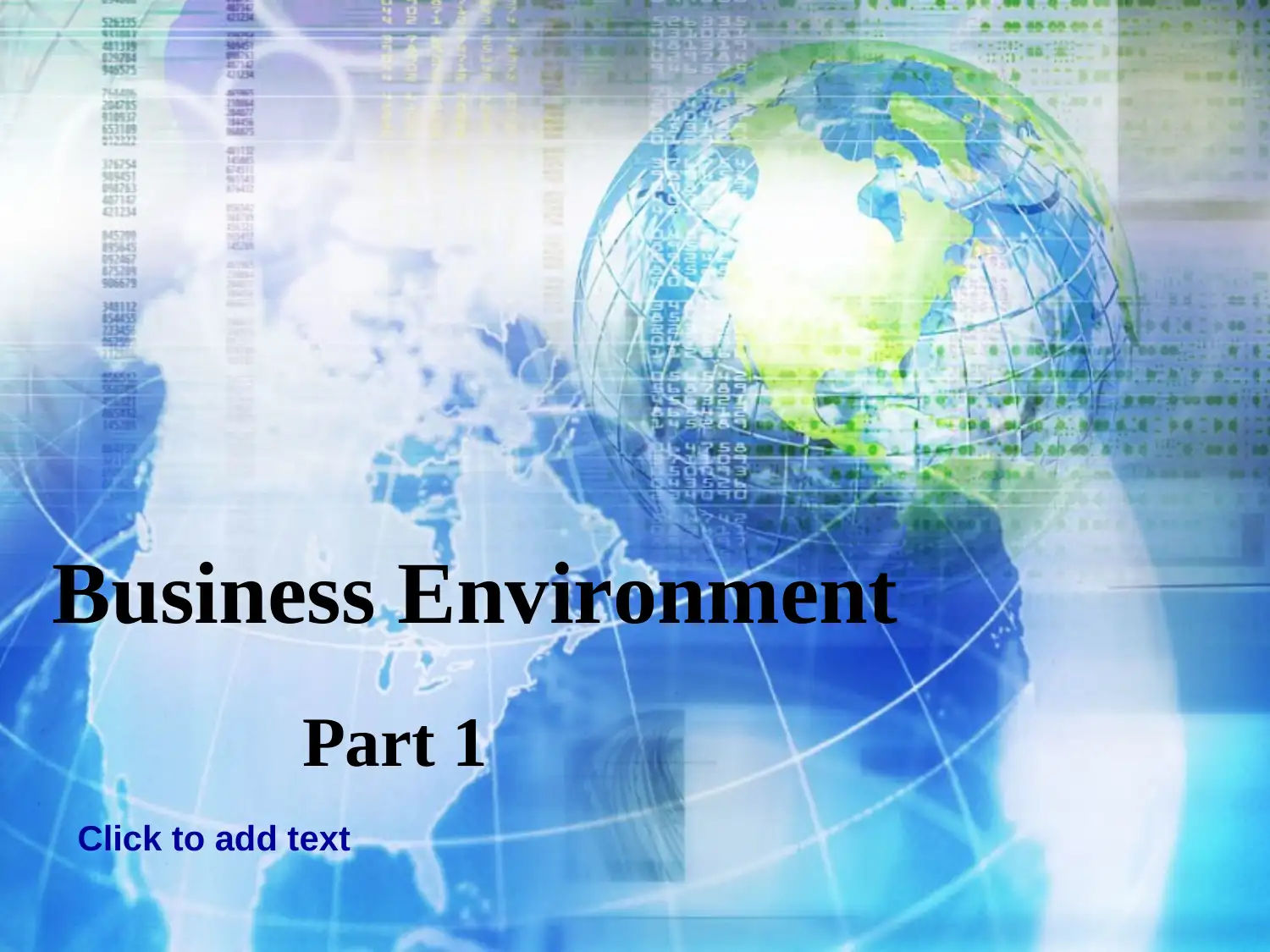
Click to add text
Business Environment
Part 1
Business Environment
Part 1
Paraphrase This Document
Need a fresh take? Get an instant paraphrase of this document with our AI Paraphraser
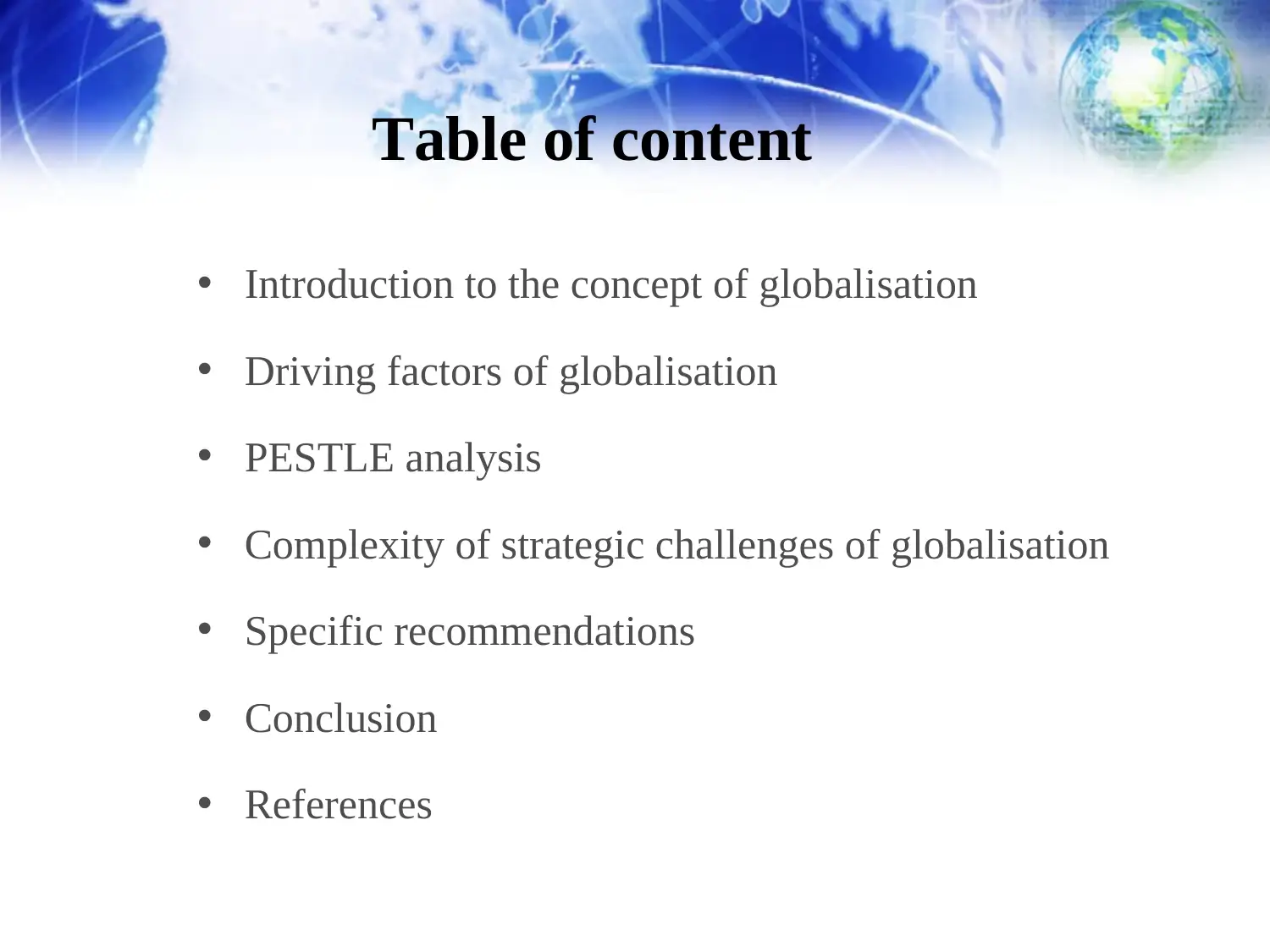
Table of content
• Introduction to the concept of globalisation
• Driving factors of globalisation
• PESTLE analysis
• Complexity of strategic challenges of globalisation
• Specific recommendations
• Conclusion
• References
• Introduction to the concept of globalisation
• Driving factors of globalisation
• PESTLE analysis
• Complexity of strategic challenges of globalisation
• Specific recommendations
• Conclusion
• References
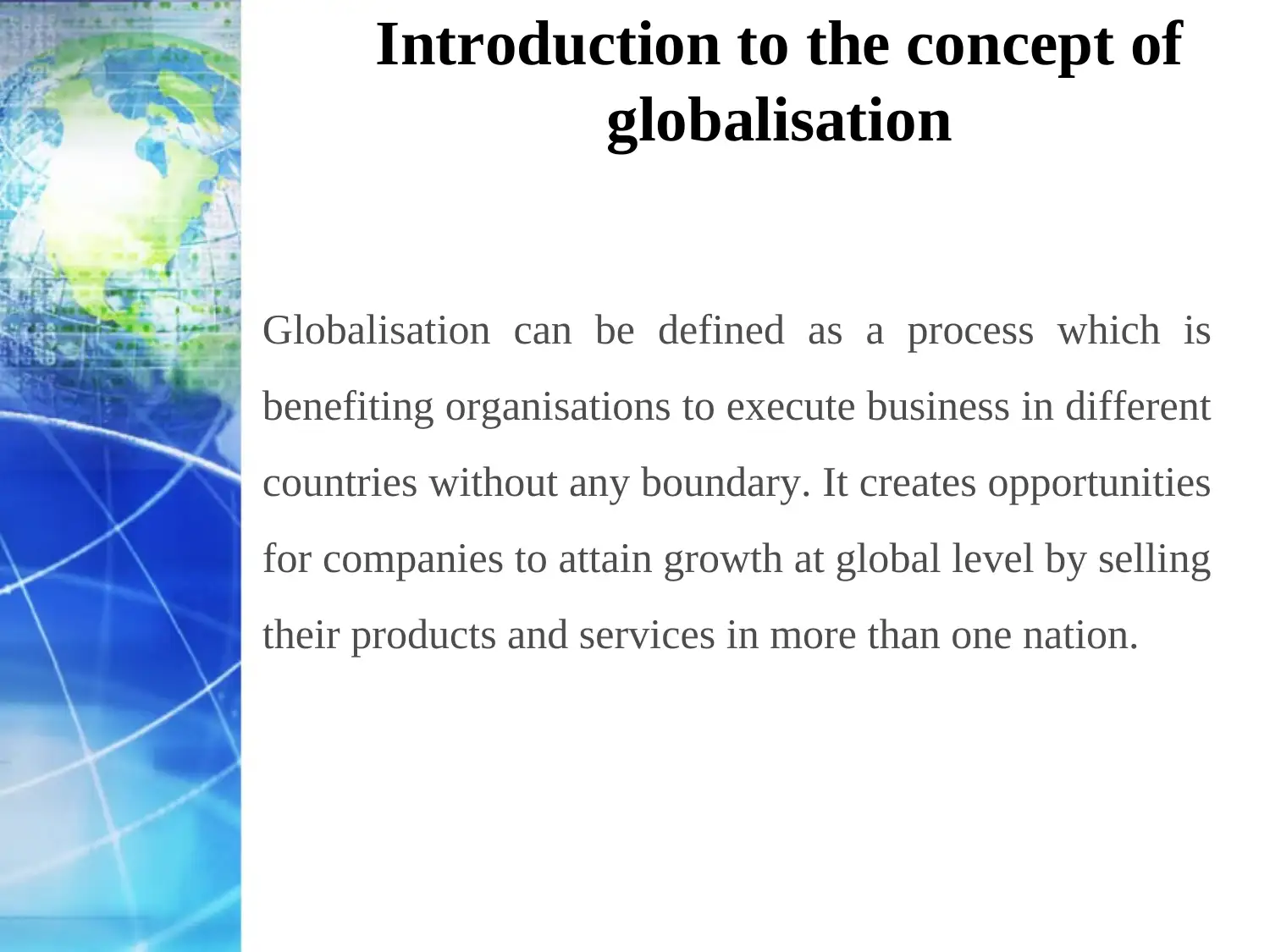
Introduction to the concept of
globalisation
Globalisation can be defined as a process which is
benefiting organisations to execute business in different
countries without any boundary. It creates opportunities
for companies to attain growth at global level by selling
their products and services in more than one nation.
globalisation
Globalisation can be defined as a process which is
benefiting organisations to execute business in different
countries without any boundary. It creates opportunities
for companies to attain growth at global level by selling
their products and services in more than one nation.
⊘ This is a preview!⊘
Do you want full access?
Subscribe today to unlock all pages.

Trusted by 1+ million students worldwide
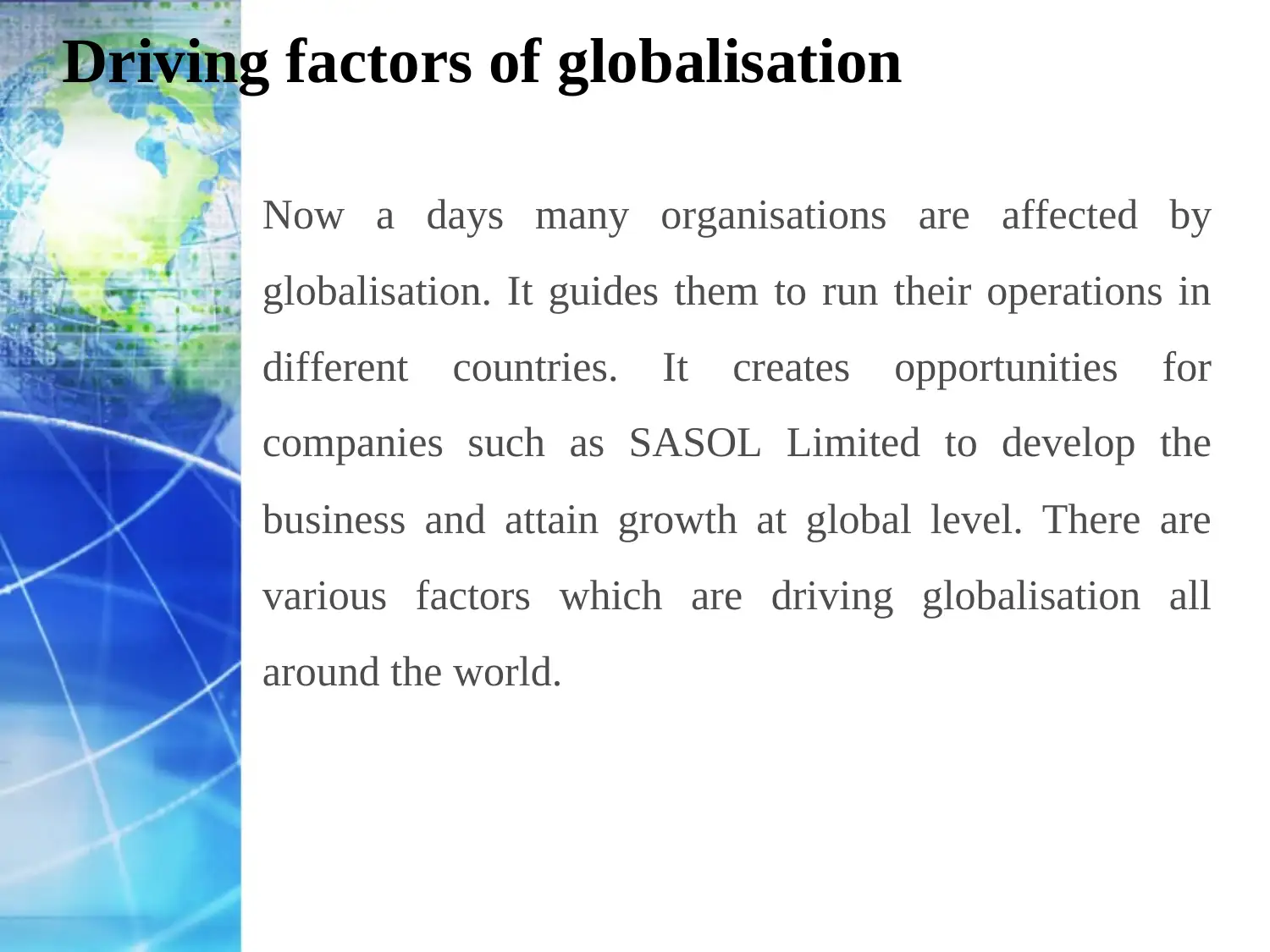
Driving factors of globalisation
Now a days many organisations are affected by
globalisation. It guides them to run their operations in
different countries. It creates opportunities for
companies such as SASOL Limited to develop the
business and attain growth at global level. There are
various factors which are driving globalisation all
around the world.
Now a days many organisations are affected by
globalisation. It guides them to run their operations in
different countries. It creates opportunities for
companies such as SASOL Limited to develop the
business and attain growth at global level. There are
various factors which are driving globalisation all
around the world.
Paraphrase This Document
Need a fresh take? Get an instant paraphrase of this document with our AI Paraphraser
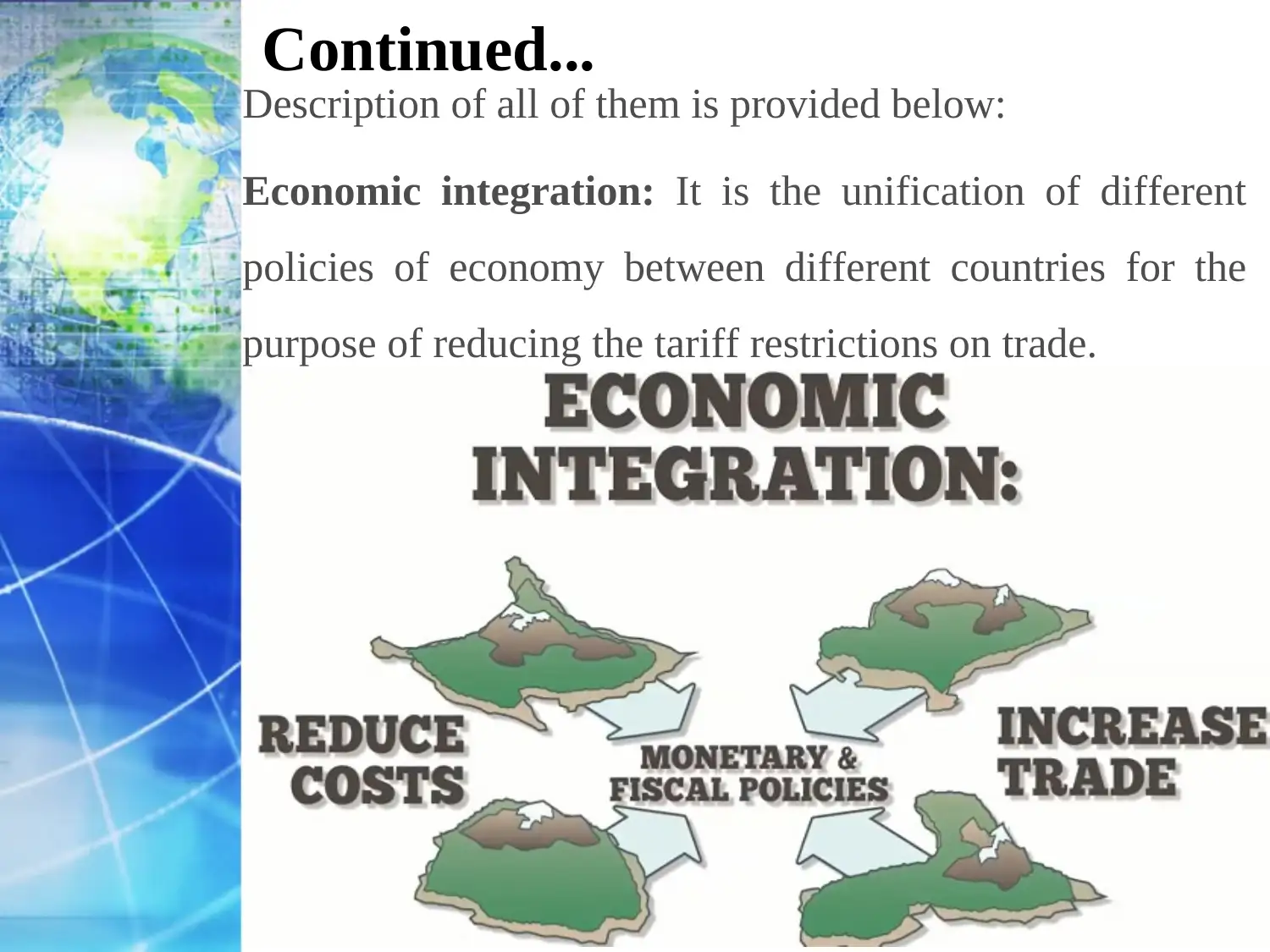
Continued...
Description of all of them is provided below:
Economic integration: It is the unification of different
policies of economy between different countries for the
purpose of reducing the tariff restrictions on trade.
Description of all of them is provided below:
Economic integration: It is the unification of different
policies of economy between different countries for the
purpose of reducing the tariff restrictions on trade.
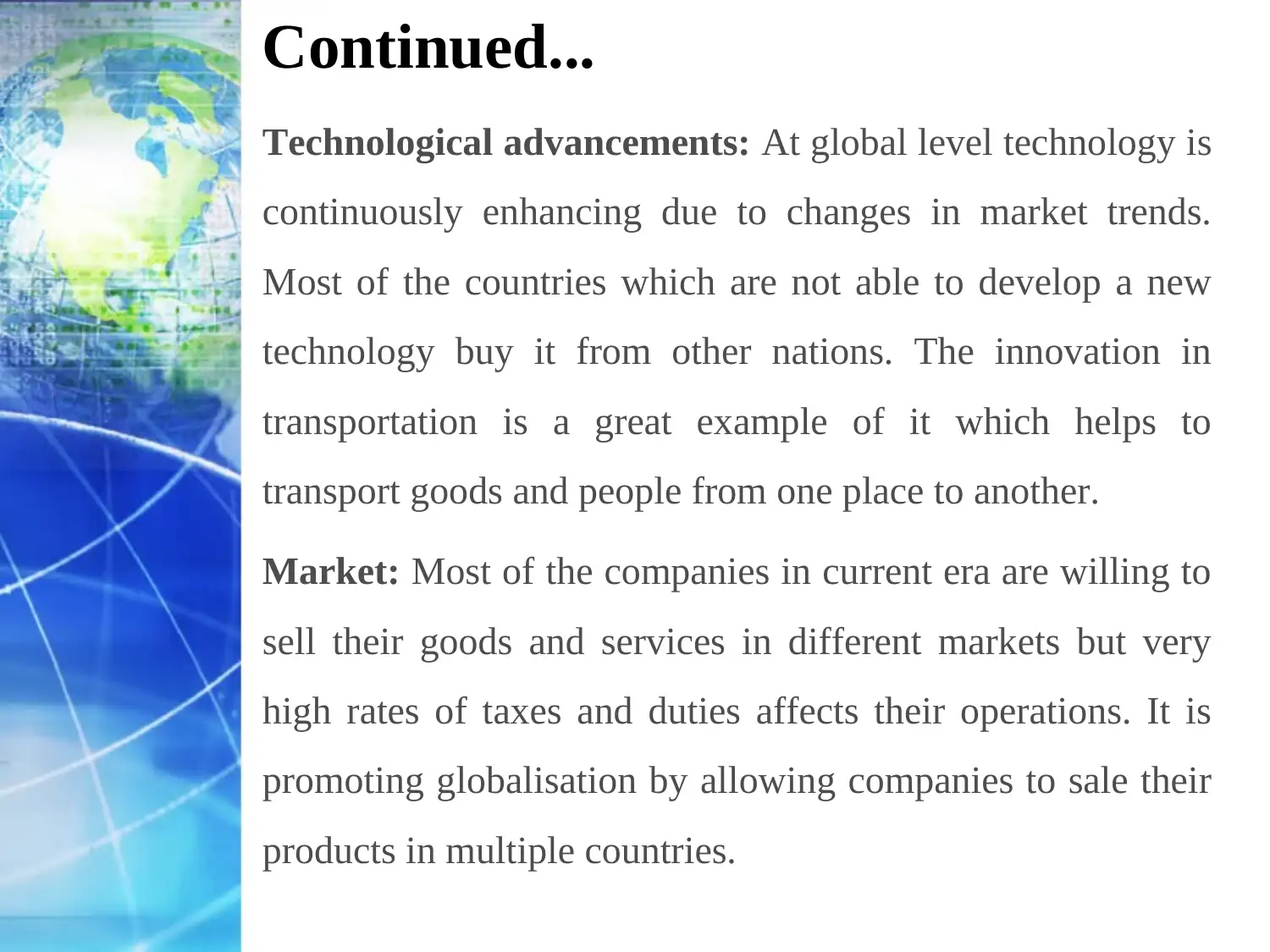
Continued...
Technological advancements: At global level technology is
continuously enhancing due to changes in market trends.
Most of the countries which are not able to develop a new
technology buy it from other nations. The innovation in
transportation is a great example of it which helps to
transport goods and people from one place to another.
Market: Most of the companies in current era are willing to
sell their goods and services in different markets but very
high rates of taxes and duties affects their operations. It is
promoting globalisation by allowing companies to sale their
products in multiple countries.
Technological advancements: At global level technology is
continuously enhancing due to changes in market trends.
Most of the countries which are not able to develop a new
technology buy it from other nations. The innovation in
transportation is a great example of it which helps to
transport goods and people from one place to another.
Market: Most of the companies in current era are willing to
sell their goods and services in different markets but very
high rates of taxes and duties affects their operations. It is
promoting globalisation by allowing companies to sale their
products in multiple countries.
⊘ This is a preview!⊘
Do you want full access?
Subscribe today to unlock all pages.

Trusted by 1+ million students worldwide
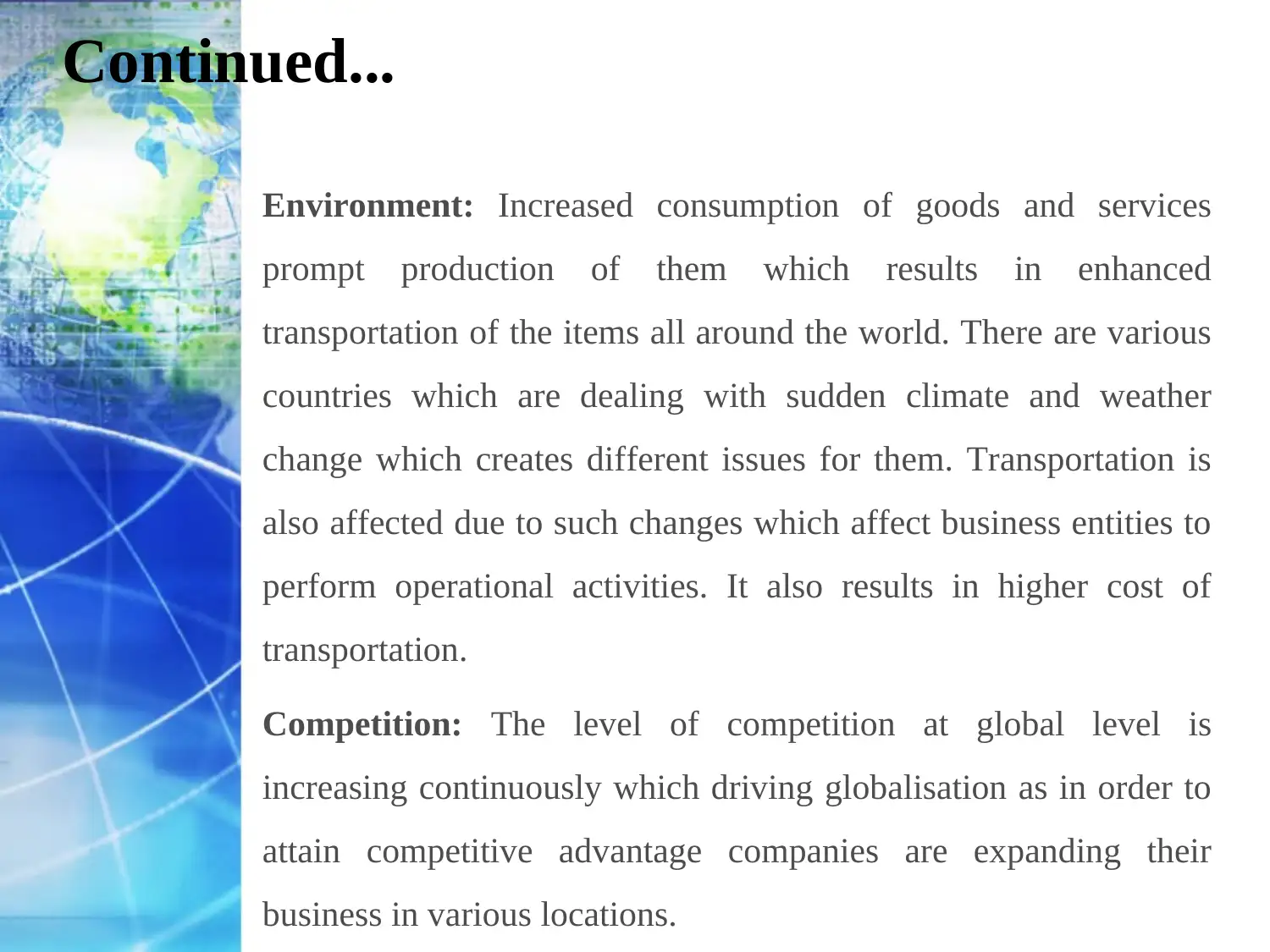
Continued...
Environment: Increased consumption of goods and services
prompt production of them which results in enhanced
transportation of the items all around the world. There are various
countries which are dealing with sudden climate and weather
change which creates different issues for them. Transportation is
also affected due to such changes which affect business entities to
perform operational activities. It also results in higher cost of
transportation.
Competition: The level of competition at global level is
increasing continuously which driving globalisation as in order to
attain competitive advantage companies are expanding their
business in various locations.
Environment: Increased consumption of goods and services
prompt production of them which results in enhanced
transportation of the items all around the world. There are various
countries which are dealing with sudden climate and weather
change which creates different issues for them. Transportation is
also affected due to such changes which affect business entities to
perform operational activities. It also results in higher cost of
transportation.
Competition: The level of competition at global level is
increasing continuously which driving globalisation as in order to
attain competitive advantage companies are expanding their
business in various locations.
Paraphrase This Document
Need a fresh take? Get an instant paraphrase of this document with our AI Paraphraser
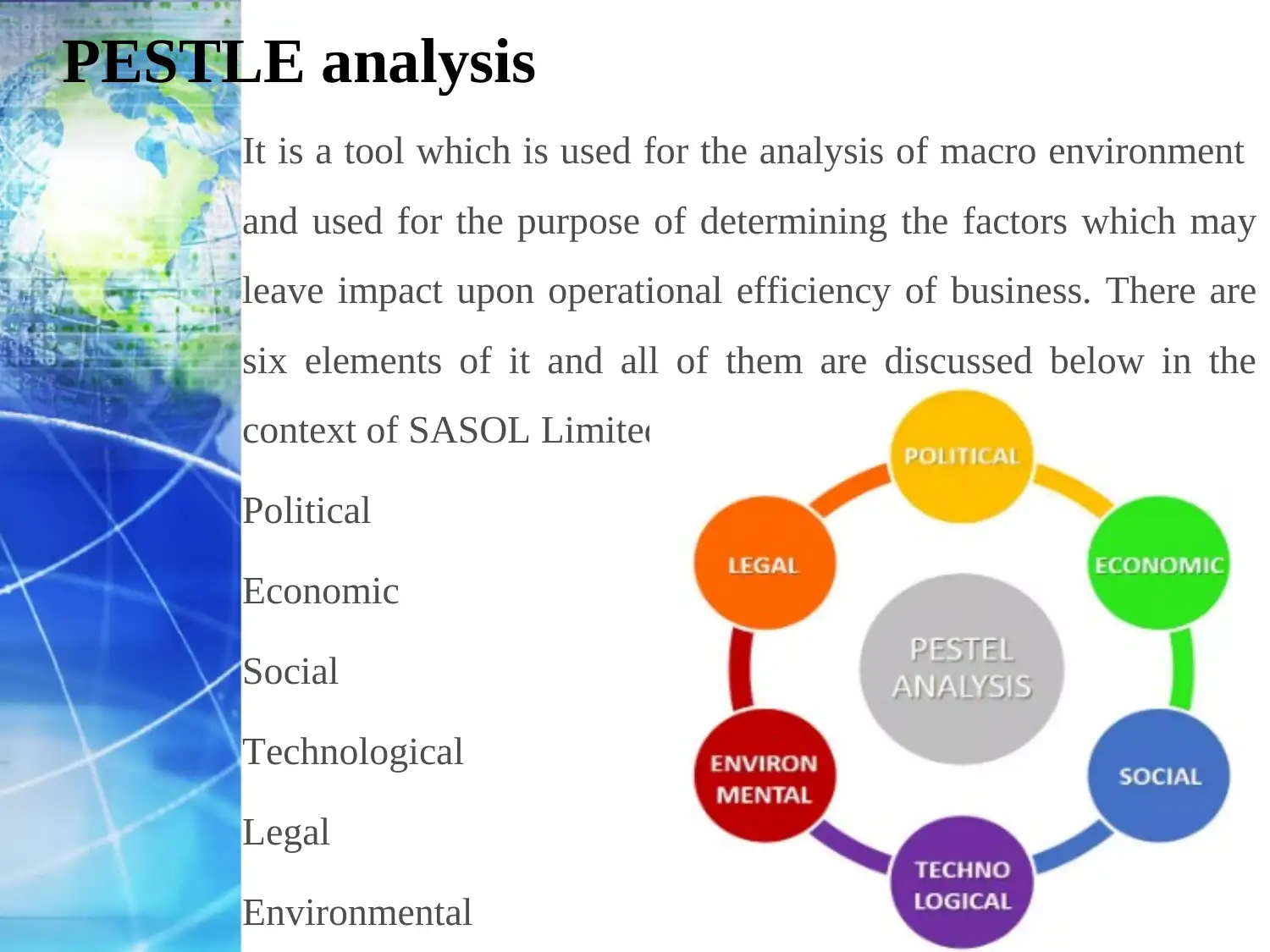
PESTLE analysis
It is a tool which is used for the analysis of macro environment
and used for the purpose of determining the factors which may
leave impact upon operational efficiency of business. There are
six elements of it and all of them are discussed below in the
context of SASOL Limited:
Political
Economic
Social
Technological
Legal
Environmental
It is a tool which is used for the analysis of macro environment
and used for the purpose of determining the factors which may
leave impact upon operational efficiency of business. There are
six elements of it and all of them are discussed below in the
context of SASOL Limited:
Political
Economic
Social
Technological
Legal
Environmental
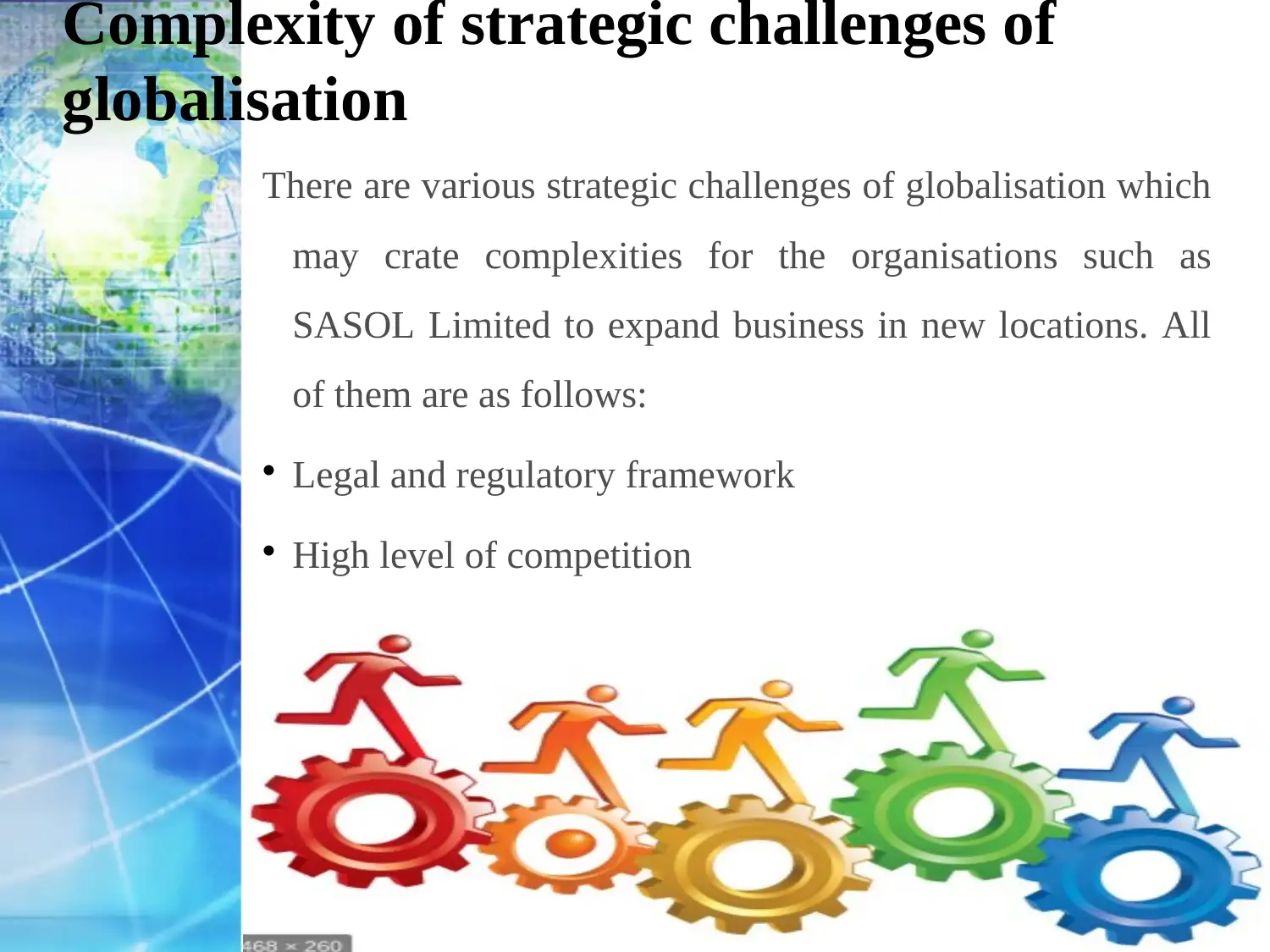
Complexity of strategic challenges of
globalisation
There are various strategic challenges of globalisation which
may crate complexities for the organisations such as
SASOL Limited to expand business in new locations. All
of them are as follows:
Legal and regulatory framework
High level of competition
globalisation
There are various strategic challenges of globalisation which
may crate complexities for the organisations such as
SASOL Limited to expand business in new locations. All
of them are as follows:
Legal and regulatory framework
High level of competition
⊘ This is a preview!⊘
Do you want full access?
Subscribe today to unlock all pages.

Trusted by 1+ million students worldwide
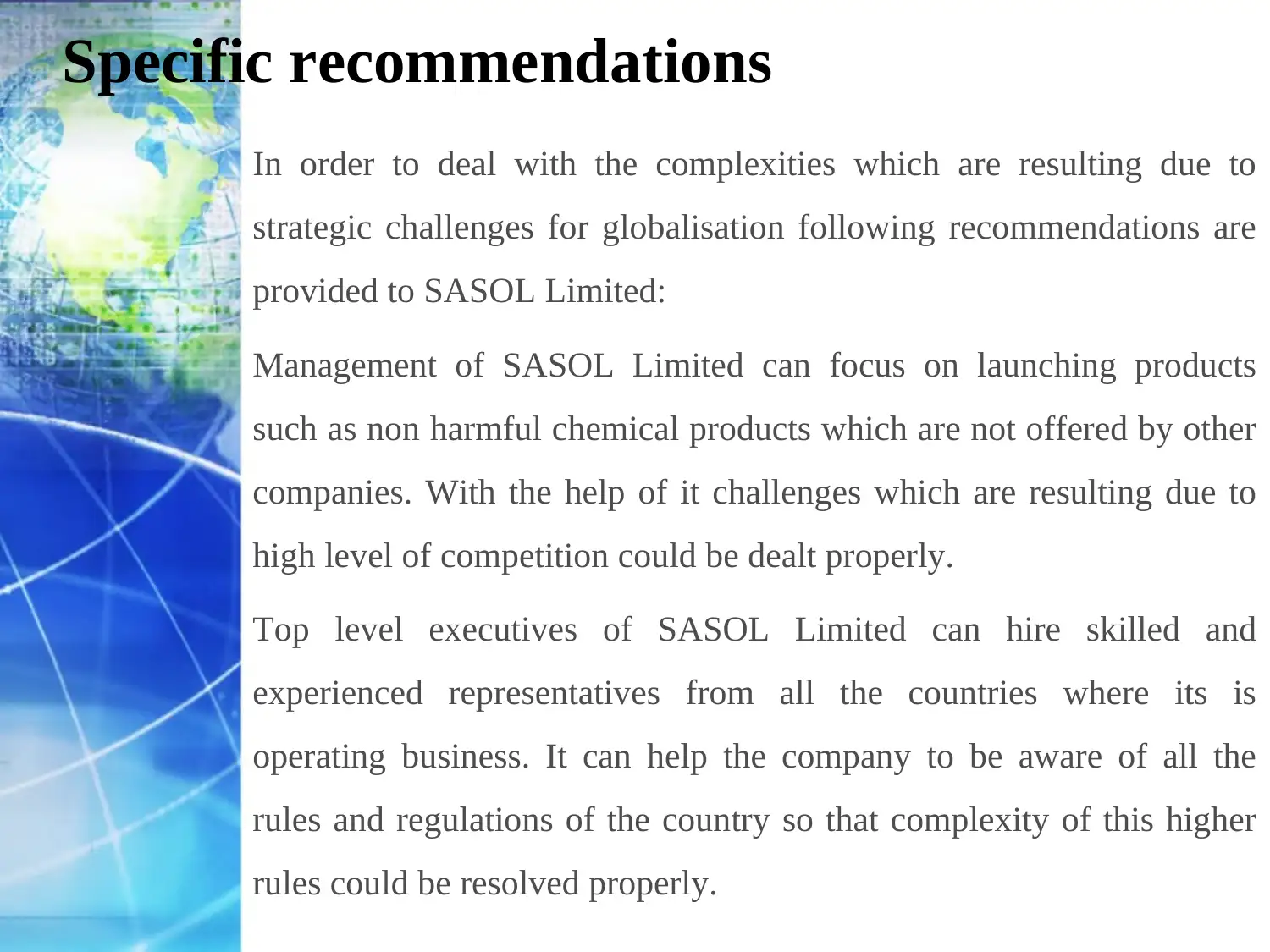
Specific recommendations
In order to deal with the complexities which are resulting due to
strategic challenges for globalisation following recommendations are
provided to SASOL Limited:
Management of SASOL Limited can focus on launching products
such as non harmful chemical products which are not offered by other
companies. With the help of it challenges which are resulting due to
high level of competition could be dealt properly.
Top level executives of SASOL Limited can hire skilled and
experienced representatives from all the countries where its is
operating business. It can help the company to be aware of all the
rules and regulations of the country so that complexity of this higher
rules could be resolved properly.
In order to deal with the complexities which are resulting due to
strategic challenges for globalisation following recommendations are
provided to SASOL Limited:
Management of SASOL Limited can focus on launching products
such as non harmful chemical products which are not offered by other
companies. With the help of it challenges which are resulting due to
high level of competition could be dealt properly.
Top level executives of SASOL Limited can hire skilled and
experienced representatives from all the countries where its is
operating business. It can help the company to be aware of all the
rules and regulations of the country so that complexity of this higher
rules could be resolved properly.
Paraphrase This Document
Need a fresh take? Get an instant paraphrase of this document with our AI Paraphraser
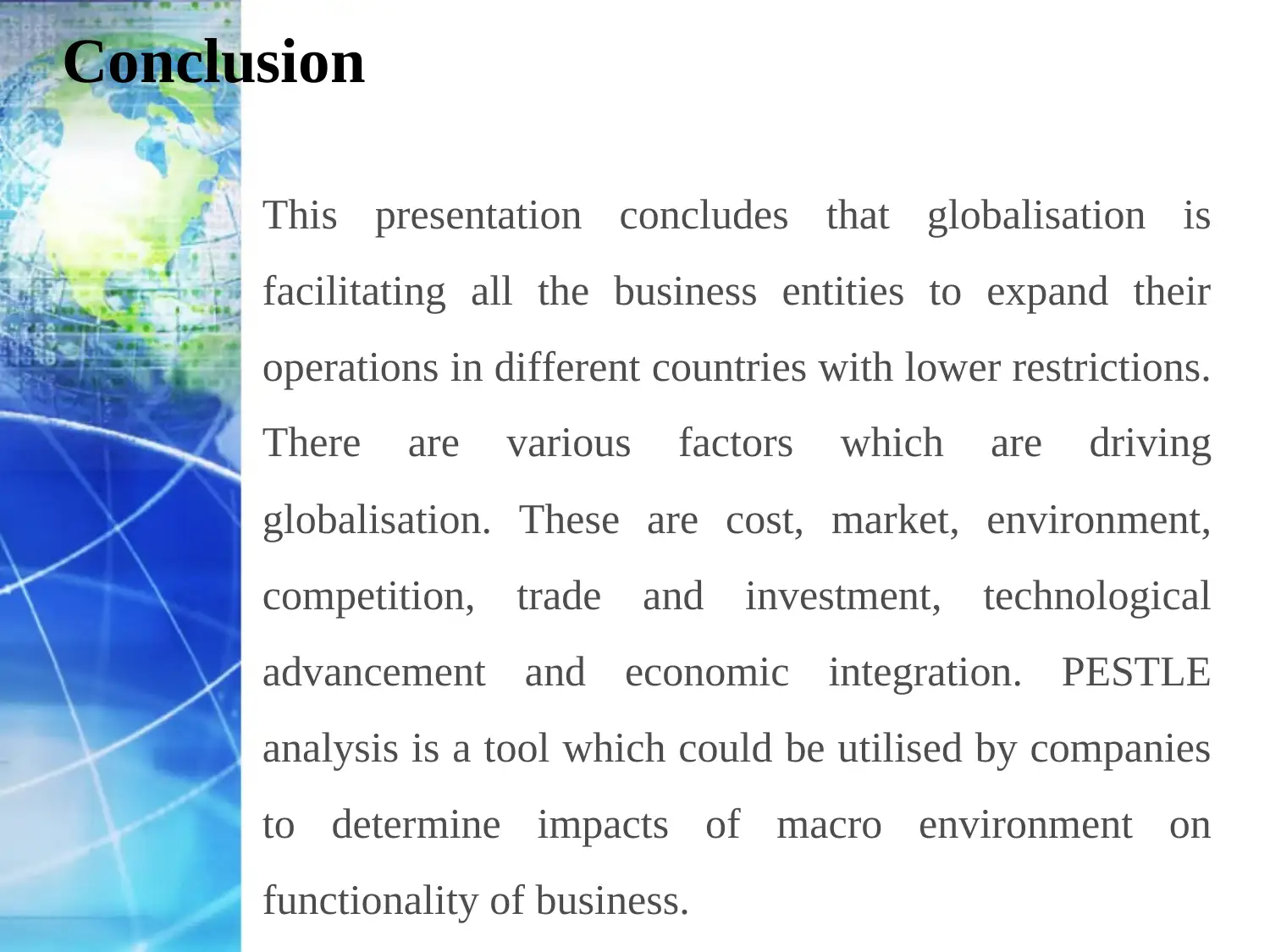
Conclusion
This presentation concludes that globalisation is
facilitating all the business entities to expand their
operations in different countries with lower restrictions.
There are various factors which are driving
globalisation. These are cost, market, environment,
competition, trade and investment, technological
advancement and economic integration. PESTLE
analysis is a tool which could be utilised by companies
to determine impacts of macro environment on
functionality of business.
This presentation concludes that globalisation is
facilitating all the business entities to expand their
operations in different countries with lower restrictions.
There are various factors which are driving
globalisation. These are cost, market, environment,
competition, trade and investment, technological
advancement and economic integration. PESTLE
analysis is a tool which could be utilised by companies
to determine impacts of macro environment on
functionality of business.
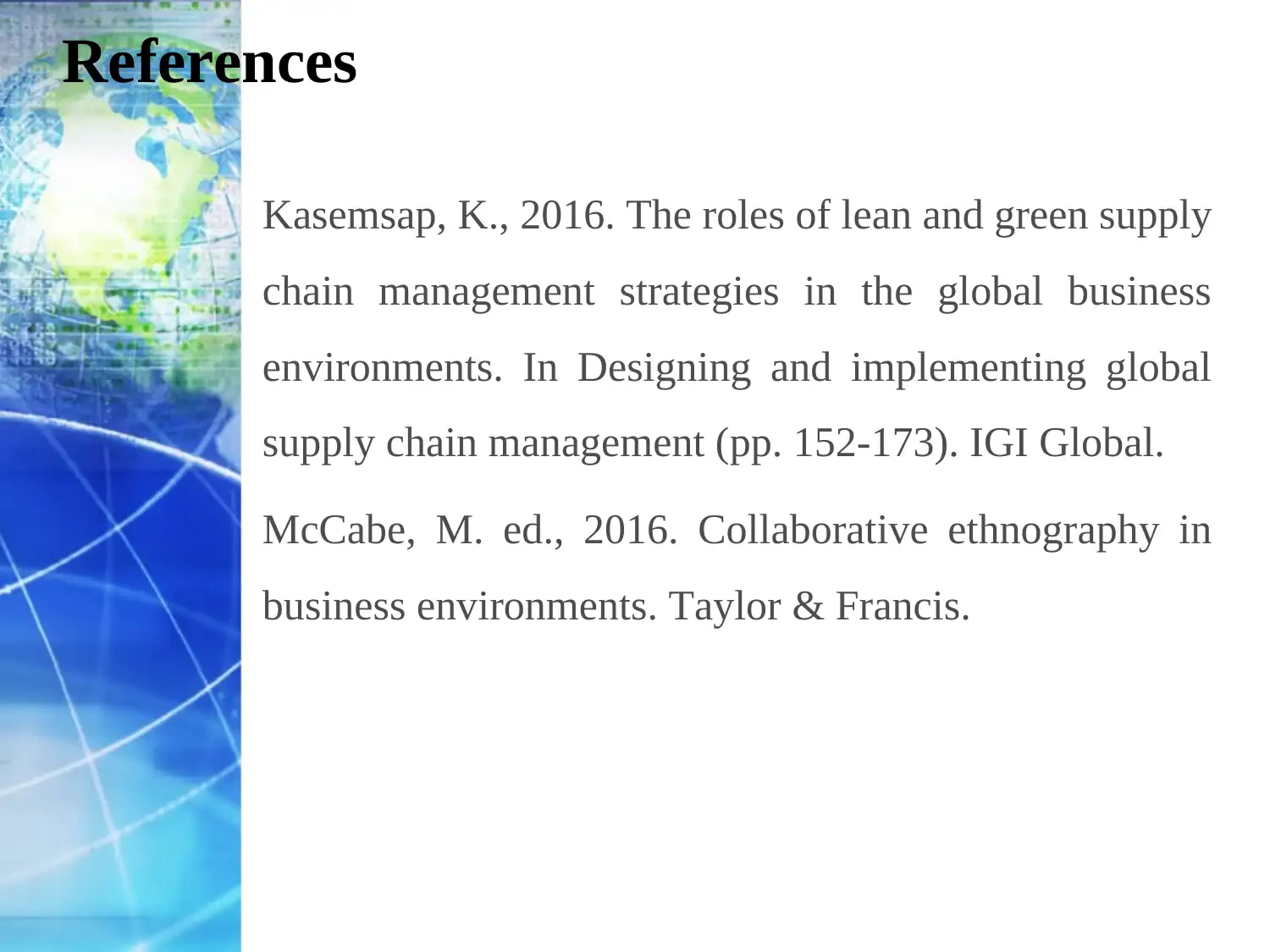
References
Kasemsap, K., 2016. The roles of lean and green supply
chain management strategies in the global business
environments. In Designing and implementing global
supply chain management (pp. 152-173). IGI Global.
McCabe, M. ed., 2016. Collaborative ethnography in
business environments. Taylor & Francis.
Kasemsap, K., 2016. The roles of lean and green supply
chain management strategies in the global business
environments. In Designing and implementing global
supply chain management (pp. 152-173). IGI Global.
McCabe, M. ed., 2016. Collaborative ethnography in
business environments. Taylor & Francis.
⊘ This is a preview!⊘
Do you want full access?
Subscribe today to unlock all pages.

Trusted by 1+ million students worldwide
1 out of 12
Related Documents
Your All-in-One AI-Powered Toolkit for Academic Success.
+13062052269
info@desklib.com
Available 24*7 on WhatsApp / Email
![[object Object]](/_next/static/media/star-bottom.7253800d.svg)
Unlock your academic potential
Copyright © 2020–2025 A2Z Services. All Rights Reserved. Developed and managed by ZUCOL.



